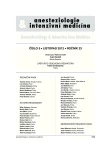Perforated peptic ulcer – pre-operative risks, postoperative morbidity and mortality, prophylaxis in intensive care and guidelines
Authors:
Satinský Igor 1,2
Authors‘ workplace:
Mezioborová jednotka intenzivní péče, Nemocnice Havířov
1; Slezská univerzita, Fakulta veřejných politik, Opava
2
Published in:
Anest. intenziv. Med., 23, 2012, č. 5, s. 259-263
Category:
Update in Intensive Care Medicine
*Novinky v oboru, Praha, prosinec 2011
Overview
This review analyses studies reporting preoperative risk factors for postoperative morbidity and mortality in patients with perforated peptic ulcer in the literature in the last 10 years. There exists a number of factors clearly associated with increased morbidity and mortality in this illness: advanced age, co-existing diseases, malnutrition, shock on admission and delayed surgery. Because some of the factors are predetermined, reduction in mortality is difficult to achieve. On the other hand detection of risk factors allows to stratify patients and to reduce the incidence of postoperative complications. Some scoring systems exist to determine the risk level (Boey’s score, Mannheim Peritonitis Index).
The first choice of treatment is early surgical suture of the perforation and plugging of the perforation with pedicled omentoplasty, accompanied by irrigation and drainage of the peritoneal cavity. The use of drains, routine postoperative nasogastric decompression and antibiotic prophylaxis should be reduced and applied in selected cases only. There is no strong evidence favouring proton pump inhibitors against H2 receptor antagonists.
Stress ulcer prophylaxis in intensive care patients should be given to at-risk patients without enteral nutrition only. Patients with enteral nutrition do not benefit from stress ulcer prophylaxis and indeed such therapy may increase the risk of nosocomial pneumonia and colitis.
Keywords:
perforated peptic ulcer – preoperative risks – postoperative mortality – prophylaxis – guidelines
Sources
1. Baron, J. H. Paintress, princess and physician’s paramour: poison or perforation? J. R. Soc. Med., 1998, 91, p. 213–216.
2. Zittel, T. T., Jehle, E. C., Becker, H. D. Surgical management of peptic ulcer disease: indication, technique and outcome. Langenbecks Arch. Surg., 2000, 385, p. 84–96.
3. Bertleff, M. J. O. E., Lange, J. F. Perforated peptic ulcer disease: a review of history and treatment. Dig. Surg., 2010, 27, p. 161–169.
4. Lau, W. Y. Perforated peptic ulcer: open versus laparoscopic repair. Asian. J. Surg., 2002, 25, p. 267–269.
5. Fujii, Y., Asato, M., Taniguchi, N. et al. Sonographic diagnosis and succesful nonoperative management of sealed perforated duodenal ulcer. J. Clin. Ultrasound., 2003, 31, p. 55–58.
6. Donovan, A. J., Berne, T. V., Donovan, J. A. Perforated duodenal ulcer: an alternative therapeutic plan. Arch. Surg., 1998, 133, p. 1166–1171.
7. Crofts, T. J., Park, K. G., Steele, R. J. et al. A randomized trial of nonoperative treatment for perforated peptic ulcer. N. Engl. J. Med., 1989, 320, p. 970–973.
8. Schein, M. To drain or not to drain? The role of drainage in the contamined and infected abdomen: an international and personal perspective. World J. Surg., 2008, 32, p. 312–321.
9. Nelson, R., Edwards, S., Tse, B. Prophylactic nasogastric decompression after abdominal surgery. Cochrane Database Syst. Rev., (on-line), 2007, CD004929.
10. Zittel, T. T., Jehle, E. C., Becker, H. D. Surgical management of peptic ulcer disease today: indication, technique and outcome. Langenbecks Arch. Surg., 2000, 385, p. 84–96.
11. Sarosi, G. A. Jr., Jaiswal, K. R., Nwariaku, F. E. et al. Surgical therapy of peptic ulcers in the 21st century: more common than you think. Am. J. Surg., 2005, 190, p. 775–779.
12. Imhof, M., Epstein, S., Ohmann, C. et al. Duration of survival after peptic ulcer perforation. World J. Surg., 2008, 32, p. 408–412.
13. Boey, J., Choi, S. K. Y., Alagaratnam, T. T., Poon, A. Risk stratification in perforated duodenal ulcers. Ann. Surg., 1987, 205, p. 22–26.
14. Linder, M. M., Wacha, H., Feldmann, U. et al. The Mannheim Peritonitis Index. An instrument for the intraoperative prognosis of peritonitis. Chirurg., 1987, 58, p. 84–92.
15. Moller, M. H., Adamsen, S., Thomsen, R. W., Moller, M. Preoperative prognostic factors for mortality in peptic ulcer perforation: a systematic review. Scandinavian J. Gastroenterology, 2010, 45, p. 785–805.
16. Skillman, J. J., Bushnell, L. S., Goldamn, H. et al. Respiratory failure, hypotension, sepsis, and jaundice. A clinical syndrome associated with lethal hemorrhage from acute stress ulceration of the stomach. Am. J. Surg., 1969, 117, p. 523–530.
17. Daley, R. J., Rebuck, J. A., Welage, L. S. et al. Prevention of stress ulceration. Current trends in critical care. Crit. Care Med., 2004, 32, p. 2008–2013.
18. Herzig, S. J., Howell, M. D., Ngo, L. H. el al. Acid-supressive medication use and the risk for hospital-acquired pneumonia. JAMA, 2009, 301, p. 2120–2128.
19. Marik, P. E., Vasu, T., Hirani, A., Pachinburavan, M. Stress ulcer prophylaxis in the new millenium: A systematic review and meta-analysis. Crit. Care Med., 2010, 38, p. 2222–2228.
Labels
Anaesthesiology, Resuscitation and Inten Intensive Care MedicineArticle was published in
Anaesthesiology and Intensive Care Medicine

2012 Issue 5
Most read in this issue
- Perforated peptic ulcer – pre-operative risks, postoperative morbidity and mortality, prophylaxis in intensive care and guidelines
- Sugammadex from the perspective of evidence-based medicine
- Pre-operative assessment
- What is calcyphylaxis and why we should not supplement calcium in patiens with hyperphosphatemia and phosphates in pateints with hypercalcemia?
